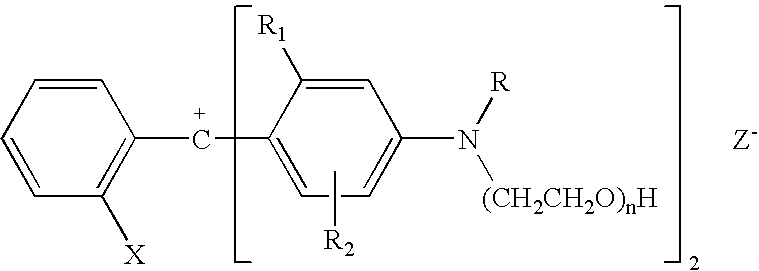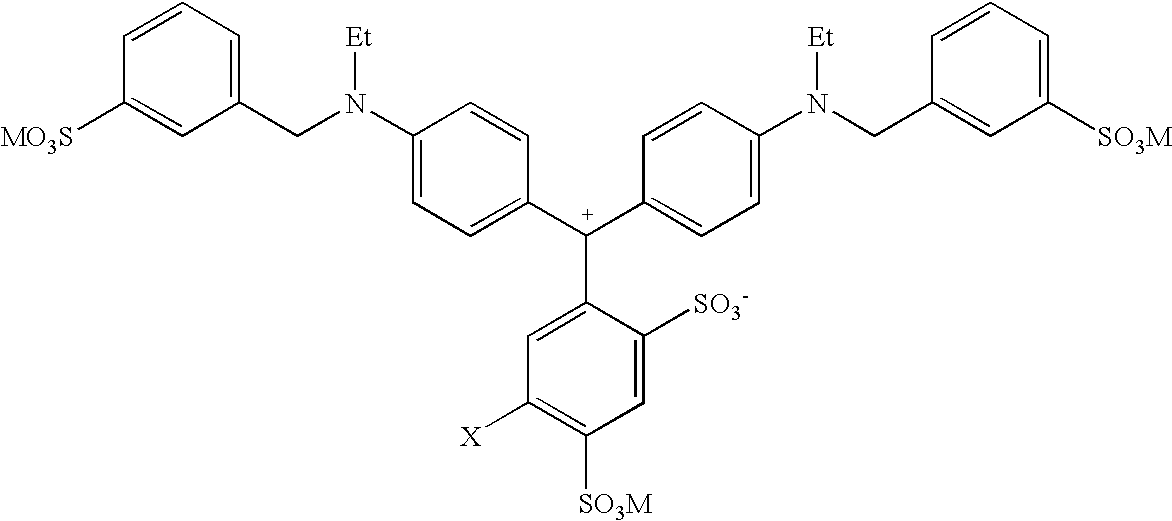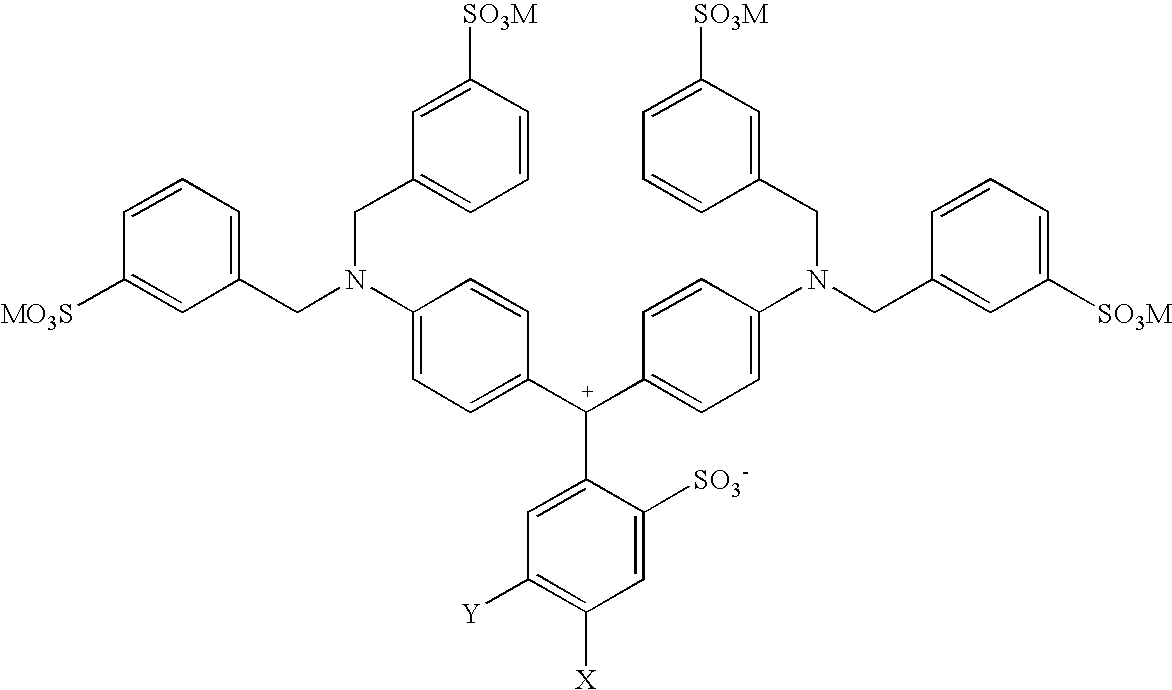Colorant compositions
a colorant composition and composition technology, applied in the field of surprising effectiveness, can solve the problems of large amount of effort to find the right molecular combination, inadvertent or undesirable discoloration, and high unpredictable sub-group substitution in this manner
- Summary
- Abstract
- Description
- Claims
- Application Information
AI Technical Summary
Problems solved by technology
Method used
Image
Examples
example 1
[0064]
[0065]To a 3-neck 500 mL round bottom flask equipped with a condenser, thermometer and a nitrogen inlet was added water (3 g), 93% sulfuric acid (18 g), water (6 g), ortho-formylbenzene sulfonic acid sodium salt (21 g), Aniline 2TBGE 12PO (173.8 g), and urea (1.2 g). The ensuing mixture was heated to 100C for 3 hours under a nitrogen atmosphere. The reaction solution was then allowed to cool to 70C and ammonium meta-vanadate (0.2 g) was added. The ensuing reaction mixture was heated to 95–107C where a mixture of water (40g) and 35% hydrogen peroxide (40 g) was slowly added. After addition of the peroxide water solution, the reaction was poured into a separatory funnel and allowed to phase. The bottom aqueous layer was removed. Water (400 g) was then added to the product layer and the mixture heated to 70C. The solution was then allowed to phase separate. The bottom product layer was removed. Water (400g) was then added to the product layer and the pH adjusted to 7 with a 1:1 m...
example 2
[0066]
[0067]To a 3-neck 500 mL round bottom flask equipped with a condenser, thermometer and a nitrogen inlet was added water (3 g), sulfuric acid (9.0 g), ortho-formylbenzene sulfonic acid sodium salt (10.5 g), Aniline 2EHG 1OPO (114.2 g), and urea (0.6 g). The ensuing mixture was heated to 100C for 3 hours under a nitrogen atmosphere. The reaction solution was then allowed to cool to 70 C and ammonium meta-vanadate (0.1 g) was added. The ensuing reaction mixture was heated to 95–107C where a mixture of water (17 g) and 35% hydrogen peroxide (20 g) was slowly added. After addition of the peroxide water solution, the reaction was poured into a separatory funnel and allowed to phase. The bottom aqueous layer was removed. Water (250 g) was then added to the product layer and the mixture heated to 70C. The solution was then allowed to phase separate. The bottom product layer was removed. Water (250g) was then added to the product layer and the pH adjusted to 5.9 with a 1:1 mixture of a...
example 3
[0068]
[0069]To a 3-neck 500 mL round bottom flask equipped with a thermometer and a N2 inlet was added 93% sulfuric acid (6 g), ortho-formylbenzene sulfonic acid sodium salt (11.5 g), Aniline 2TBGE10 EO (89.6g), and urea (0.55 g). The ensuing mixture was heated to 95C for 3 hours under a N2 atmosphere. The reaction solution was then allowed to cool to ambient temperature and ammonium meta-vanadate (0.44 g) was added. The ensuing reaction mixture was heated to 95–105C where a mixture of water (7.5 g) and 35% hydrogen peroxide (18.5 g) was slowly added. After addition of the peroxide water solution, the mixture was allowed to cool to ambient temperature. The pH was adjusted to 6.3 with a 1:1 mixture of aqua ammonia and water to give a green solution with a color value of 27.4 (measured with a Beckman DU 650 UV visible spectrophotometer; abs / g / L in Methanol) and a Max Abs of 634 nm.
PUM
| Property | Measurement | Unit |
|---|---|---|
| density | aaaaa | aaaaa |
| structure | aaaaa | aaaaa |
| color degradation | aaaaa | aaaaa |
Abstract
Description
Claims
Application Information
 Login to view more
Login to view more - R&D Engineer
- R&D Manager
- IP Professional
- Industry Leading Data Capabilities
- Powerful AI technology
- Patent DNA Extraction
Browse by: Latest US Patents, China's latest patents, Technical Efficacy Thesaurus, Application Domain, Technology Topic.
© 2024 PatSnap. All rights reserved.Legal|Privacy policy|Modern Slavery Act Transparency Statement|Sitemap



